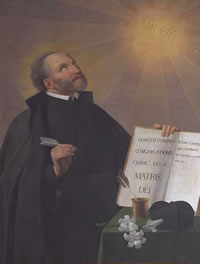John Leonardi
This article needs additional citations for verification. (November 2021) |
Clerics Regular of the Mother of God of Lucca |
|---|
John Leonardi, OMD (
Biography
He was the youngest of seven children born to middle-class parents in Diecimo (now within the
In 1574, he founded a group charged with deepening Christian faith and devotion; this foundation was part of the wider movement of the
Founding the order
He became interested in the reforms instituted by the

Civic leaders in Lucca opposed the establishment of a new religious order for political reasons and acted to stop its formation. While ultimately ineffective, their efforts forced John Leonardi to spend most of the remainder of his life outside Lucca,
In 1603, he founded along with Cardinal J. Vivès, the seminary of the Propagation of the Faith for the philosophical and theological training of missionary priests. In 1621, his community would formally be designated "Clerks Regular of the Mother of God'". The final Rule of his institute was published in 1851. Two houses of the Clerks Regular of the Mother of God were opened when he died, and three others were opened in the seventeenth century.
Death and sainthood
He died on October 9, 1609, of influenza, which he contracted while ministering to his brothers suffering from the epidemic raging in Rome at the time.[5]
He was venerated for his miracles and his religious fervor. His memory was held so high in Rome that Pope Leo XIII added his name to the Roman Martyrology, and ordered Roman clergy to celebrate his Mass and Office, an honor otherwise strictly limited to beatified popes.
Leonardi was beatified in 1861 and canonized in 1938 by
References
- ^ (October 7, 2009). On St. John Leonardi Archived 2011-09-13 at the Wayback Machine. ZENIT.
- ^ "St John Leonardi". Catholic Online. Retrieved 31 January 2022.
- ISBN 0-385-13594-7.
- ^ a b c "Saint John Leonardi’s Story", Franciscan Media
- ^ a b c Britannica, The Editors of Encyclopaedia. "Saint John Leonardi". Encyclopedia Britannica
- ^ Carmichael, Montgomery. "Clerks Regular of the Mother of God of Lucca." The Catholic Encyclopedia Vol. 4. New York: Robert Appleton Company, 1908. 12 November 2021
 This article incorporates text from this source, which is in the public domain.
This article incorporates text from this source, which is in the public domain.
- ^ Schofield, Nicholas. "Santa Maria in Campitelli: an old Roman church with strong British connections", Venerable English College, Rome, 26 February 2020
Sources
- "Encyclopédie des Saints et de la Sainteté," Hachette (in French)
- Alberto Comuzzi (1988). San Giovanni Leonardi : un nomo per tutte le vocazioni [San Juan Leonardi : un hombre apasionado por Cristo y por la Iglesia] (in Italian, French, and Spanish) (4th ed.). Cinisello Balsamo (Milan); Santiago de Chile: Edizioni Paoline. p. 167.
- Bernard Baudouin (2016). Encyclopédie des saints : tous les saints de l'Église de Rome, leurs oeuvres & leurs bienfaits (in French). Bulgary: Éditions Trajectoire DL. p. 330. )
